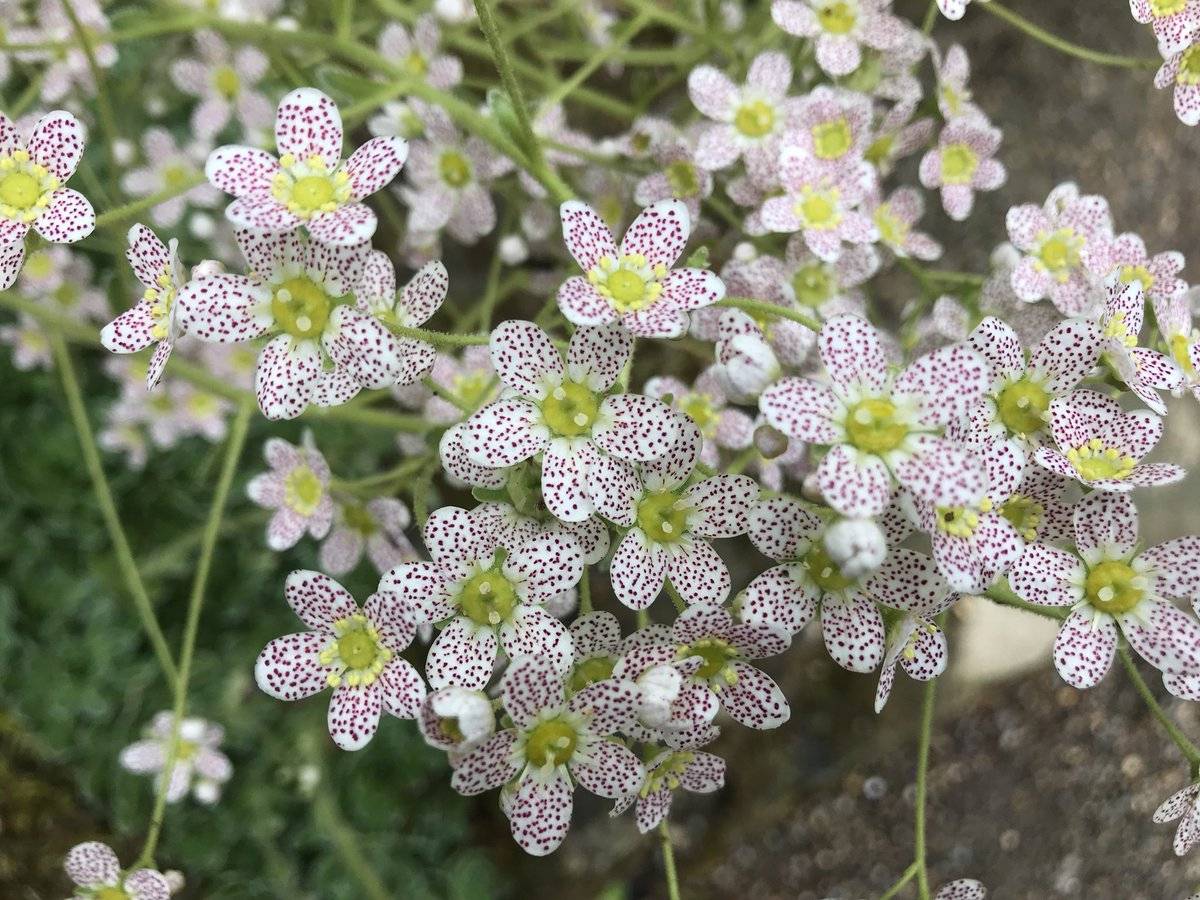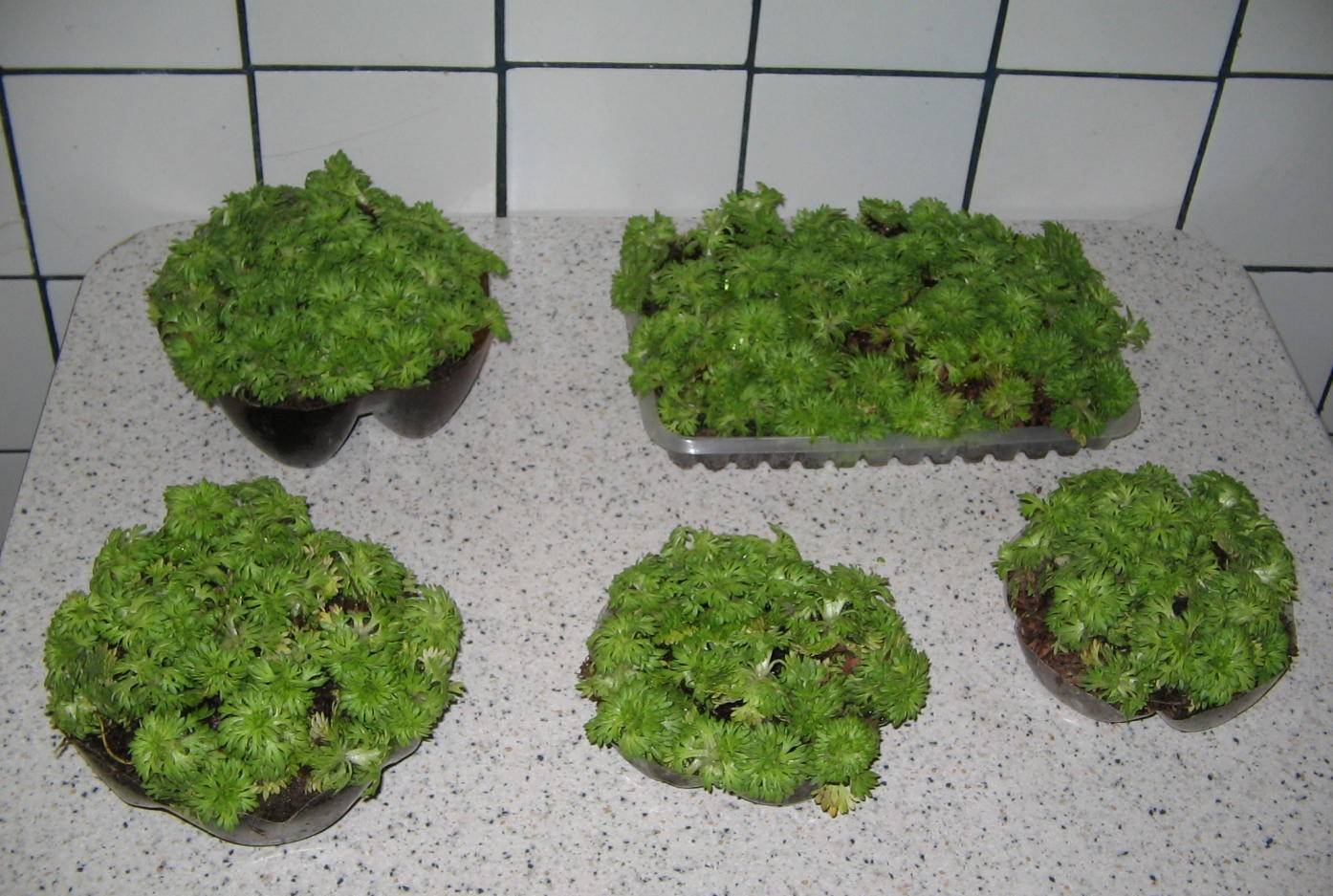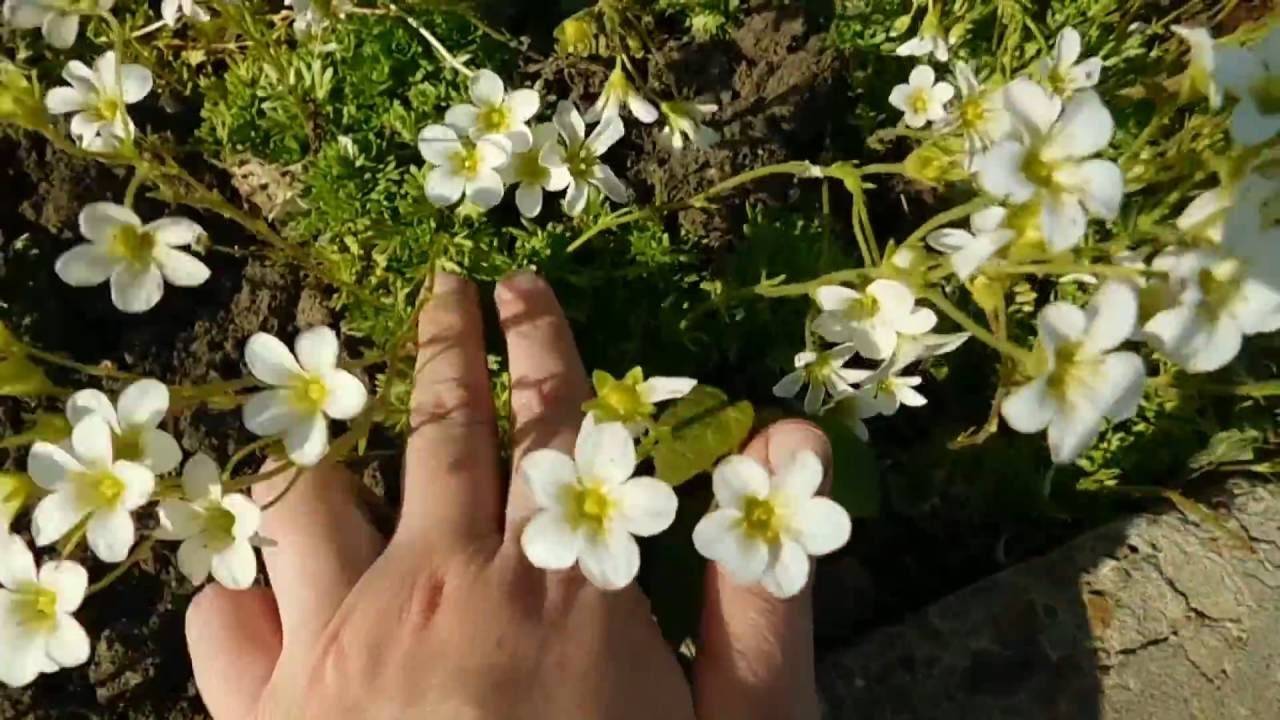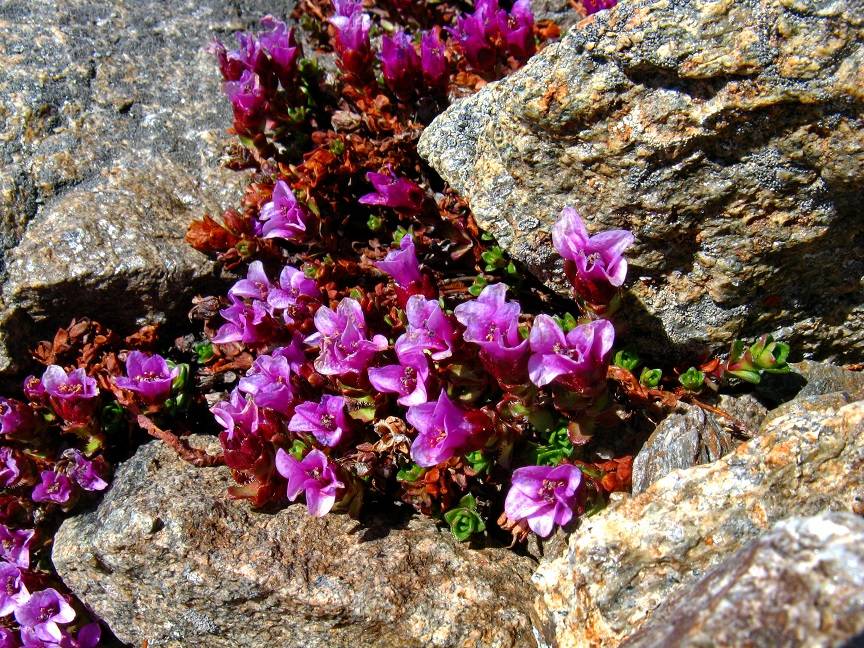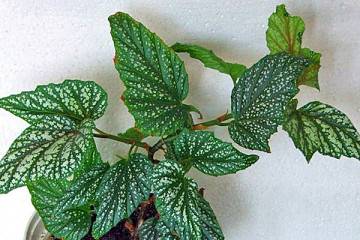Saxifrage flower - planting and home care
Content:
Nature is truly unique and sometimes amazes by the fact that plants can not only exist, but also actively develop under rather unfavorable conditions. Saxifrage of incredible beauty can grow in mountains, deserts, sands and poor land. At the same time, the plant perfectly tolerates both drought and frost, delighting people for a long time with variegated flowers.
What does a saxifrage look like?
Many gardeners, both experienced and novice, decorate rockeries and rocky gardens with saxifrage. The popularity is due to the bright and long flowering, as well as the ability to adapt to a variety of growing conditions.
The charming plant does not take up much space, it grows and multiplies quickly. Saxifrage in landscape design is used to decorate borders and as a ground cover plant.
The flower leaves are olive green with a reddish tint and silvery veins. The saxifrage leaves are tightly pressed to the ground and are generally rounded, but there are also plants with heart-shaped, diamond-shaped and feathery forms. In diameter, they grow up to 6 cm.Most species reach a height ranging from 15 to 20 cm.The exception is long-leaved saxifrage, which grows up to 60 cm.At the beginning of May, shoots with buds at the end begin to rise from the dense mass of leaves, which subsequently open ... The flowers are medium-sized, often collected in small inflorescences, sometimes solitary.
Common varieties
Saxifrage flowers are very popular ornamental plants. Due to their unpretentiousness, they are grown both indoors and in garden conditions. Today there are about 450 varieties of these plants, but the following are considered the most popular:
- Saxifrage paniculata is a perennial ornamental plant, which is also called eternally alive. In nature, you can find a flower on limestone slopes, rocky soils, granite ledges and rocks. It grows up to 10 cm in height. The leaves are oblong, pointed, blue-green or gray-green. Growing up, the flower forms an evergreen thick carpet. During flowering, it expels shoots, on which small flowers are formed, collected in paniculate inflorescences. Saxifrage blooms with white or whitish-yellowish flowers;
- Saxifrage shade is a frost-resistant, evergreen, herbaceous plant that grows mainly on moist soil in shady places. Differs in dense dark green foliage. The leaves have a rounded shape at the ends and grow in length no more than 5 cm. The flowers are small, collected in inflorescences of a light pink hue. Duration of flowering - 30 days;
- turfy - a plant with a short, but very beautiful flowering. The flower reaches a height of 20 cm, forming dense tussocks.The stem is erect, growing from the center of the rosette, forming a flower shoot, on which one or several small flowers bloom. It blooms for three weeks. Basal short-petiolate leaves, divided into lobes from 3 to 5 pcs. The leaf blades of the soddy saxifrage are densely lowered with smooth edges and rounded tips;
- Arends is a perennial ornamental herb. The leaves of the variety are separate, glossy, collected in a deep green outlet. The flowers are rounded with a double perianth. The calyx of the flower is dark green, and the saxifrage flower itself is pink, white, purple, yellow or lilac. The plant grows in height from 10 to 20 cm. In the process of growth, dense moss thickets are formed, which by their external features resemble forest moss, covering the entire earth with a mantle. The flowering period lasts 30 days, blooms in late May - early June. Ideally, the plant feels in semi-shaded wet areas;
- cotyledon has high decorative qualities. Leaves are fleshy, dense, ligulate or oval in shape with small denticles along the edges. The shade of the leaves is green with a glossy sheen and a white lime deposit around the edges. Flowers are formed on peduncles from 20 to 60 cm high, they are collected in paniculate inflorescences. The shape of the flowers is aligned, star-shaped, a shade of whitish-pink. This variety belongs to indoor saxifrage, so it can feel great both at home and in the open field.
Healing properties
The medicinal properties are explained by the diverse organic and chemical composition of the saxifrage. The flower is believed to have the following effects on the body:
- anti-inflammatory;
- pain reliever;
- anti-febrile;
- calming;
- bactericidal;
- anti-infective.
In addition, in small doses, the herb in women increases lactation, and a decoction made from the leaves relieves fever and helps with frostbite.
History of appearance
They began to cultivate saxifrage a long time ago, in 1600. A full botanical description appeared in 1779. The French scientist D. Villard was studying this plant. He devoted almost his entire life to the study and cultivation of this unique plant.
Care features
Because of its unpretentiousness, the saxifrage is considered the favorite of flower growers. In the process of growing, even novice gardeners have no problems, since it is easy and simple to care for it. At the same time, in order for the plant to please the eye and bloom, it is necessary to treat the process responsibly. For placement, it is best to choose any window, except for the southern one.
Temperature
After planting a saxifrage, caring for it should begin with maintaining the optimum temperature. In the summer period, the most optimal is considered to be from 20 ° С to 22 ° С, in winter it is necessary to lower the indicators to 15 ° С.
Lighting
The saxifrage plant does not like direct sunlight and excess light. In this case, the leaves of the plant become light. And, conversely, in insufficient light, the flower stops blooming, grows slowly, and the leaves become small. It is considered the most optimal to cover the leaves from the midday sun and open in the morning and evening.
Watering
The plant does not like waterlogging, as well as drying out of the soil, therefore it is recommended to water it little by little, but often.
Spraying
As a houseplant, saxifrage perfectly tolerates dry air and does not require spraying.
Humidity
Saxifrage requires moderately moist soil.To give the flower a presentable appearance, flower growers recommend spraying the leaves in dry weather.
Priming
In order for an attractive saxifrage to grow, planting and care require certain rules to be followed. Before planting, you must definitely pay attention to the soil, which should not have stagnant moisture and be heavy. Before planting a saxifrage, the soil can be purchased at the store or prepared by yourself. It should include sand, crushed limestone, leaf humus and peat.
Top dressing
It is necessary to feed the plant only with compounds that contain minerals. After planting, fertilizer is applied for the first time a week later, and then feeding is carried out twice a month.
Features of care in winter and during flowering
In winter and during the flowering period, feeding stops. The flower belongs to frost-hardy, therefore it tolerates winter perfectly. The exception is young, immature specimens of some varieties, which are better to cover for the winter.
Planting and caring for saxifrage outdoors is no different from growing at home. The only difference is that in winter it is recommended to place the flower in a room with an air temperature of about 15 ° C.
Transfer
This is an integral part of saxifrage care. Thanks to her, the plant rejuvenates. At the same time, it is not recommended to carry it out too often. This viable plant can grow favorably and look great in one place from 5 to 7 years.
When and how it blooms
The saxifrage is an amazing plant with very bright, sophisticated and beautiful flowers. They are collected in paniculate or racemose inflorescences. Having decided to plant a flower in their home, many novice growers are wondering when saxifrage blooms.
Saxifrages bloom with purple-pink, white or yellow flowers. Duration of flowering - from May to August. Some species bloom for 30 days. During flowering, saxifrage exudes a pleasant, light floral aroma.
How saxifrage reproduces
Reproduction of a flower is not difficult, while different species can reproduce in different ways. Saxifrage can be propagated by seeds, cuttings, and by dividing the bush.
Germinating seeds
The most popular way is to reproduce and grow saxifrage from seeds at home, despite the fact that the process is not quick and takes a certain amount of time. Seeds are sown in a pot in March-April, pre-treated with cold.
To grow a flower in this way, the seeds should be sown in a container with nutritious soil, sprinkled with a thin layer of substrate, and then sprayed with a spray bottle. After that, the seeds are removed to the refrigerator for 14-20 days. After this time, they take it out and put it on a light windowsill. The seeds should be kept at temperatures between 18 ° C and 20 ° C. If all conditions are met, the seedlings will appear in a week.
During this time, care consists in maintaining optimal humidity. As soon as 3-4 true leaves are formed on the seedlings, they are seated in separate cups, and then planted in open ground at the beginning of summer.
Rooting cuttings
In any period of growth, the flower can be propagated by cuttings. This requires the selection of a separate process. For its proper planting, you need to pick up a container and pour sand into it, and then moisten it and you can plant a cutting. Then the container is placed in a cool place. After a few weeks, roots should appear on the sprout, and then it can be transferred to a more illuminated place, the air temperature in which will be at least 18 ° C.Keep the sprout in such conditions for several more weeks, and then you can transplant it into open ground.
Dividing the bush
This method is suitable not only for growing a new plant, but also for renewing an old one.
You first need to prepare the holes, and water the adult plant thoroughly. Dig up a large bush and carefully remove the soil from the roots, then select green stems with good healthy roots. New plants must be immediately planted in the holes, sprinkled with soil and watered with warm, settled water. Fertilizer is allowed to be applied only after two weeks.
Possible growing problems and diseases
While growing a plant, you can face the following common diseases:
- fungal infections or rust. Their development indicates improper watering. You can fix the problem by treating the flower with a copper-based preparation;
- excess moisture can provoke powdery mildew. You can cope with the disease by spraying the saxifrage with propiconazole or bitteranol;
- if the flower sheds buds and leaves, then this indicates an attack by a spider mite. Insecticides will help in the fight against it;
- excess light and too high temperature lead to the fact that the leaves begin to fade, and the plant stops growing;
- if the tips of the leaves begin to dry and become stained, then root rot due to excess moisture may be the cause.
As for pests, an excessively high air temperature can provoke their appearance. In this case, the appearance of a spider mite, green aphid, mealybug or thrips is possible.
Saxifrage is a common herb. This unique flower can grow in absolutely any conditions: in the shade, on stones, rocks. In addition to its attractive appearance, the flower is distinguished by its unpretentious care, as well as unique healing properties.

